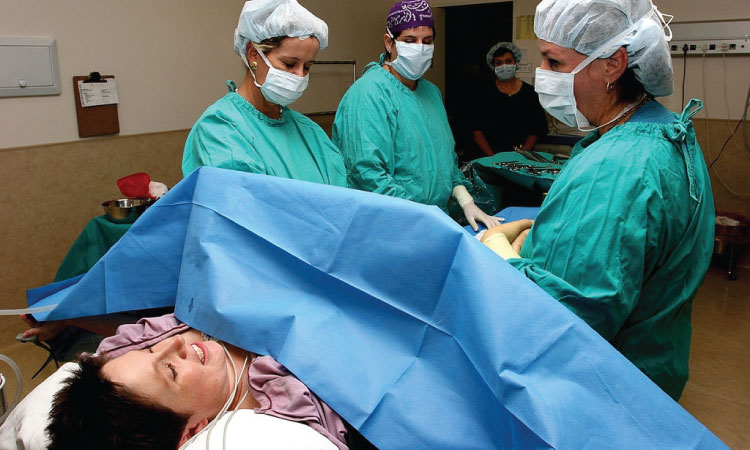C-sections – or rather, the aftermath of them – are always difficult to get through. It is a time of bleeding and clumsy mobility and careful postures and uncomfortable recovery. On top of all that, you now have to care for a newborn. So, it is no surprise that you are wondering about the dos and don’ts after a c-section and need some help.
We understand how overwhelming all this can get for you. Hugs.
You may be worrying about what you can do to have a speedy recovery, and about what will impede your restoration to full health. Well, this article will help you put your mind at ease. It sheds some light on a few dos and don’ts after a c-section, as well as a few situations you can expect to encounter.
Recovering From A C-section- How Long Does It Take?
You have just been through a major abdominal surgery. It is not reasonable to expect to be completely okay right afterward. As with any other major operation, you will take some time to heal.
Unfortunately, pain is unavoidable. In addition to going through a surgery, you have also just given life to a baby. This will take a toll on you, and you will need to be pretty patient with your recovery process.
For the first 7-10 days after your cesarean section, you will need to take medication for pain relief. Sometimes, you may have to do this for longer. Even after this period, it is normal to feel soreness and discomfort around the scar.
Do not forget that during this time you also have to look after a newborn! So, it goes without saying that you may not be able to follow all the rules you would follow after any other major surgery.
Usually, full recovery and healing will take around six weeks. However, in order to feel ready to do activities such as exercise, or sexual intercourse, it can take about 8 weeks, maybe even longer.
Keep in mind that each person is different. Your healing process may well be different, faster or slower, than other women. What is important is to take care of both yourself and your baby. As long as you do that, you should have a fairly speedy recovery!
How Do I know my C-section is healing?
You can know this by checking your c-section scar at the 6-week mark. By this point, the opening will have closed and healed. No fluid will seep out through the wound. All you will have is a scar, about 4-6 inches long.
The scar should no longer be so tender or sore. Its color will have changed. It will go from red to pink.
However, if you feel like your scar isn’t healing as it should, here are some signs that implicate complications.
- Pus or other fluids seeping from the wound
- Pain when urinating
- Swelling around the wound and abdomen
- Redness around the area
- Fever
- Severe pain in the abdominal area
If you notice any of these after the 6 weeks, consult a doctor immediately.
5 Dos After A C-section

Here are 5 dos to be followed after a C-section to minimize pain and risk of injuries.
1. Do after a C-section – Get plenty of rest
As mentioned above, a c-section is a major surgery, which means that your body needs plenty of time to completely heal. Sleeping well is mandatory. However, so many things can make sleeping after a C-section difficult.
After your delivery, as long as there are no complications, you will still have to stay a few days at the hospital. It takes even longer for the body to somewhat restore to its healthy being – about six weeks.
So, you need to give your body that time. Easier said, right? When you have a newborn in the house, it gets infinitely difficult to get a little bit of me-time. There are so many things to be done, and your little one requires a lot of care and attention.
So, here is a little bit of advice to have time to rest: take rest when your baby does. Whenever your baby naps, you also take a nap. When you put your baby to bed, go to bed yourself soon after. Ask your spouse, friends, or relatives to help if the baby wakes up at night.
You might think that this doesn’t do much, seeing as babies don’t really sleep for several hours on end. But remember that every minute helps, and you deserve a good night’s sleep.
2. Do after a C-section – Seek help
This is one of the most important do after delivery, no matter vaginal or C-section.
No matter how desired and miraculous your baby is, no mother can deny that caring for a little one is very difficult. Giving a baby the care they need after such a major operation? Even more so!
So, it is no surprise that many new mothers feel overwhelmed and exhausted. You need time to care for yourself, just as much as you need to care for the baby.
Related Reading: 12 Reasons You Do Not Feel Sexually Attracted to Husband After Baby
So, never be afraid to talk to your friends and family, or seek their help. If you have a partner, don’t be hesitant to ask them to take care of the baby for some of the time. It is as much their responsibility as it is yours. If you do not have a spouse or partner, try to have someone living with you, at least for the first couple of months, to help you out.
Your family and friends can be a great help during this time, too. Whether it is babysitting every now and then, or helping to clean the house sometimes, having some people to help you out can be a blessing. Reach out to them! Every mother needs a support system.
3. Do after a C-section – Incision Care
Many new mothers forget this important do after a C-section. Incision care should be one of the top priorities after a c-section. Follow all the after-care procedures as per the advice of your doctor Take all measures to avoid infections.
Avoid taking a hot water bath, tub bath, or shower until your incision is fully healed. Never take off the incision tape placed by the doctor purposefully before it falls off on its own.
Always keep the incision area clean and dry. Apply the ointments prescribed by the doctor as per the instruction. At the same time, never use any products on your wound without the doctor’s permission. Also, never ignore symptoms like fever, headache, and nausea as it could be a sign of infection.
4. Do after a C-section – Seek support for breastfeeding
According to studies, C-section and breastfeeding difficulties are mutually related. Many new mothers experience delays in breast milk production after a c-section. Also, positioning the baby will be difficult with the wound in the abdomen.
Related Reading: 9 Biggest Challenges Of Breastfeeding No One Prepares You For
Never hesitate to seek support from a lactation consultant to find a comfortable position. Also, you can use breastfeeding support pillows to make breastfeeding after a c-section easier.
5. Do after a C-section – Focus on nutrition and stay hydrated
Good nutrition is crucial after a C-section to speed up the healing process. Focus on fresh vegetables and fruits. Also include whole grains and low-fat dairy products. Also include fiber-rich food that brings down the risk of constipation.
It is important to make sure you are receiving all the macronutrients and micronutrients that are essential for fast healing.
Related Reading: 11 Foods To Avoid After Cesarean Delivery – Know Them Here
Also, drink plenty of water as keeping yourself well hydrated will make sure your body is functioning properly. It will help maintain your energy levels, help prevent constipation and other digestive issues, and also has played a role in breast milk production.
5 Don’ts After A C-section

The first thing you need to avoid doing when it comes to post c-section is touching or otherwise disturbing your c-section wound. This could increase the risk of infection of the wound and can stop it from healing quickly.
Here are 5 don’ts for after you have a c-section:
1. Don’t after a C-section – Exercise only when you are ready
After having a c-section, you should definitely try to move around. You can go outside for a short, relaxing stroll, or if that is too difficult, you can walk around your house itself. It may be pretty tempting to stay in bed all day, but this is not good for you.
Walking around like this, in a way that does not tire you, will ease you back to physical activity, and it doesn’t affect your scar. It also helps reduce the chance of blood clots.
However, while light activity like this is fine, you should avoid exercising too much, or doing any heavy exercise, until you feel back to full health, and your doctor gives you the go-ahead. Postpartum exercise too early can pose some risks, so start with them when you are fully ready.
This includes running, circuit training, weightlifting, jogging, sit-ups, and any such heavy exercises. You should also avoid straining yourself by going up and down the stairs all day. It can cause strain on your abdomen and scar. Try to make it so that you only rarely, if at all, make the trip upstairs/downstairs. Set up camp on one floor of your house.
Even light exercise should be avoided for the first few days until your doctor tells you it is safe to do so. At any cost, avoid putting pressure on your abdomen. It can cause complications such as bleeding.
2. Don’t after a C-section – Lifting weights or hunch over
While you can of course hold your baby (there aren’t many ways you can avoid that) you should avoid picking up or holding anything heavier than your little one. Do not lift weights during this time.
Anything requiring heavy labor should be avoided. This means no rearranging your furniture. That can wait. Ask someone else to help with household chores. It is only for a few weeks!
Even lifting your baby should be approached with caution. If you feel discomfort or pain, put the baby down immediately. You can also use a Snugglebundle to help with this. It will take some of the pressure off your stomach.
Related Reading: How To Deal With Tailbone Pain After C Section
Heavy lifting during this time can be the cause of many post-c-section complications, including infection, bleeding, and it can hinder your recovery. Remember, it takes time for your insides to heal fully.
Another thing you should avoid is hunching over. Bending after C-section might be more comfortable at first as you might worry that straightening up will pop your stitches. In fact, straightening up has a lot of benefits. It will stretch and strengthen the muscles in your abdomen, and help you heal faster.
3. Don’t after a C-section – Driving
Try not to drive for the first 4-6 weeks after your c-section, until the scar heals. If this proves impossible in the long run, avoid driving for at least the first 3 weeks. Not only can there be a bit of pain and pressure on the abdomen if you have to hit the brakes quickly, in case of an accident, but there is also every chance that your car insurance will be affected due to the surgery.
Ask someone for help traveling from place to place, and for the less urgent matters, like picking up groceries, ask your partner or friend to do it for you.
Even doctors normally suggest that you avoid driving until your scar has healed. That way, when you do drive again, you will feel in control of the car and can maneuver it without fear of pain.
4. Don’t after a C-section – Sex until you feel ready
This usually depends more on whether or not you are ready, and if you feel fully healed. Just like normal delivery, you can have sex after you are back to full health, which can vary from person to person.
Your doctor will probably suggest that you wait for 4-6 weeks after the c-section to have sex again. This is so that you can make sure you are fully healed.
As mentioned above, putting strain on your abdominal area is unwise at this time, and can lead to complications.
Related Reading: 9 Tips to Cope with A Sexless Marriage After Baby
5. Don’t after a C-section – Laugh, cough, or sneeze (impossible, but try to avoid it):
These activities can cause a lot of strain on your abdominal muscles, as well as the stitches. It can cause a sharp, piercing pain in your gut. So, while it is impossible to avoid this completely, it would be wise to avoid it as much as you can.
If you feel the need to cough, laugh, or sneeze coming on, something you can do to reduce the pressure and pain is to press a soft pillow over your stitches as you do it.
Conclusion
C-section, no matter elective or emergency, is a major surgery that needs close monitoring and follow-ups in the upcoming days. It is important to strictly follow the doctor’s instructions. Also, avoid self-treating with pain killers no matter how much pain you are experiencing. Talk to your doctor if you still experience intense pain even after 6 weeks.
Having a c- section and recovering from it is not as simple as one thinks. However, you can make it easier by following the above guidelines.

